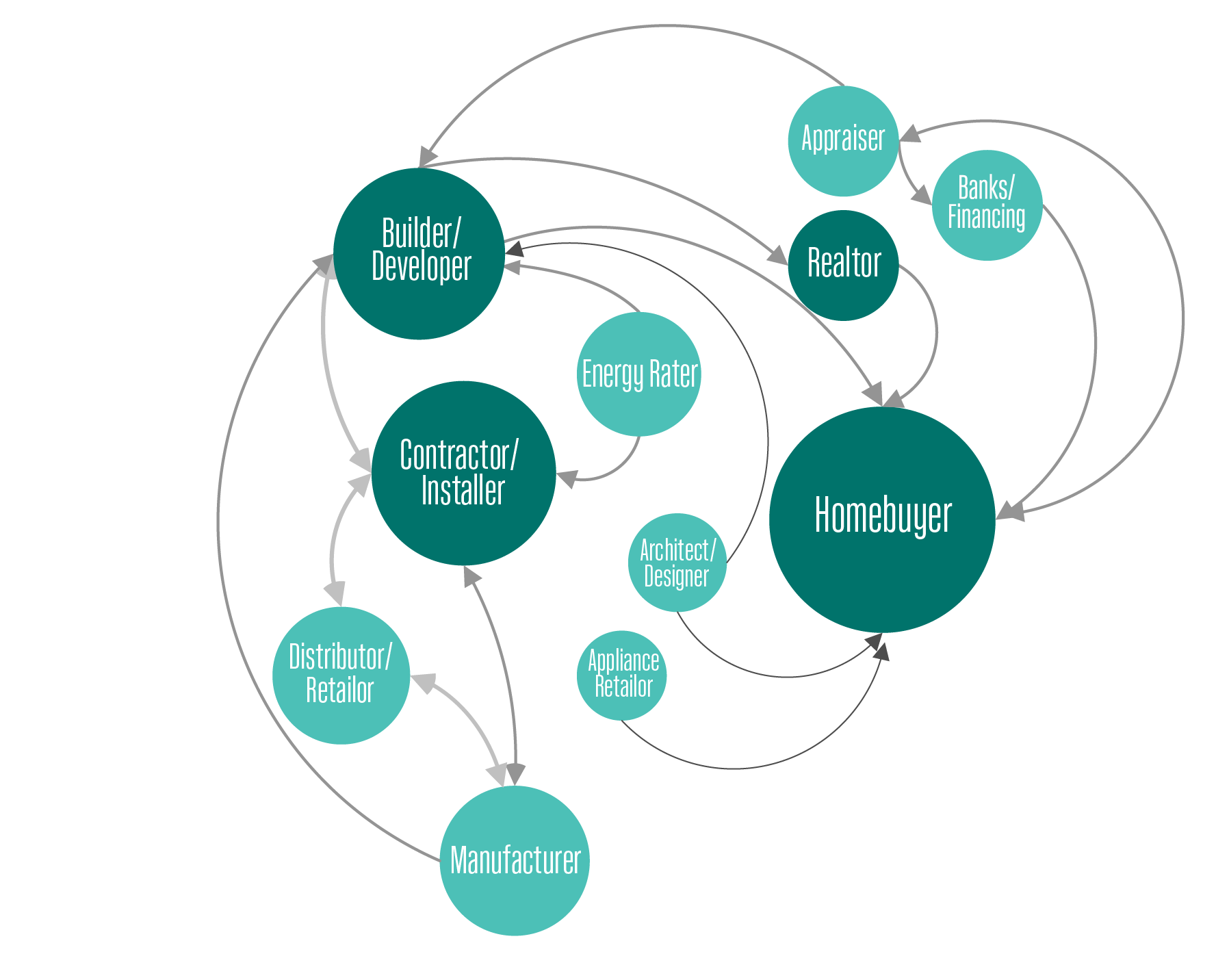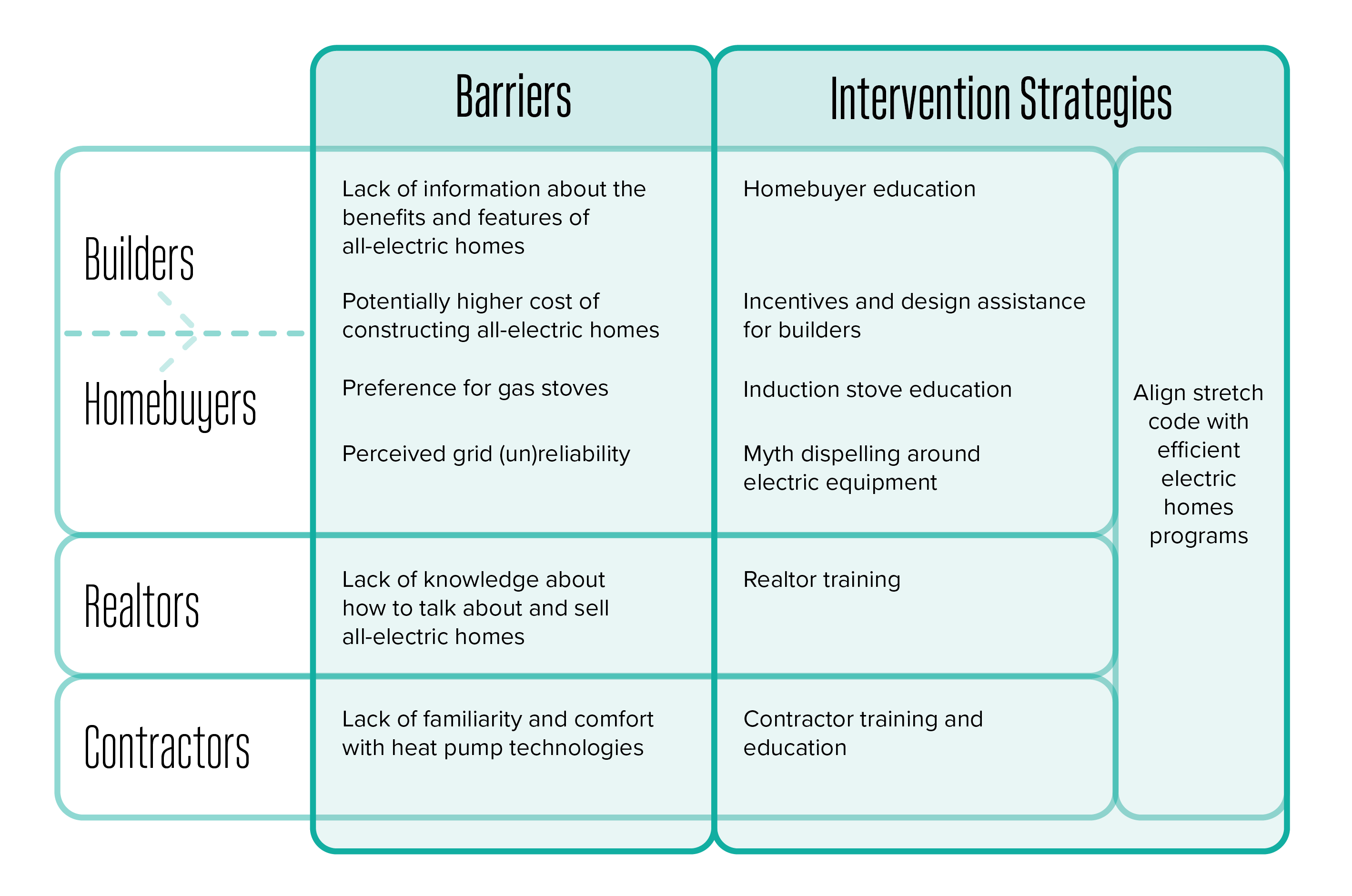
Decarbonization is the cornerstone of many climate action plans, and the electrification of the residential sector presents an opportunity to reduce residential home emissions. ILLUME investigated the market actors that have the power to influence electrifying the residential sector to better understand the barriers that exist for market transformation and the intervention opportunities available.
The Challenge
Home electrification is a key tool in reaching federal, state, and local decarbonization goals. However, for many reasons, the current market does not widely favor all-electric new homes. To better understand the barriers and opportunities to the homes of the future, ILLUME researched the new home construction industry to identify the market actors—and the decision-making between these actors—with the power to influence the electrification of homes.
The Approach
In 2022, an electric utility client started exploring market transformation programs for new home construction and asked ILLUME to help them better understand program approaches and next steps. While the utility sought to understand if a whole-home or equipment-only electrification program approach would be more successful, the ILLUME Team discovered that understanding the market actors and their decision-making dynamics presented an opportunity to influence the electrification of new homes. ILLUME conducted a host of primary and secondary research tasks to investigate and understand the new home construction market, to include:
- Interviewed local home builders, raters, realtors, architects, HVAC manufacturers, new construction program implementors, and the regional Green Building Organization.
- Defined and mapped key new residential market actors and their decision-making dynamics.
- Reviewed new construction programs across the country, their logic models, and program evaluation approaches.
The Results
We learned that the new construction market has many actors, and decision-making between these actors is complex and interconnected. We identified four key market actors:
 Homebuyers
Homebuyers
Homebuyers ultimately purchase homes and there is potential for them to heavily influence the types of homes being built. For homebuyers to drive the construction of electric homes, they need information that clearly communicates the benefits—comfort, indoor air quality, operating costs—of electrification and to understand what to look for. This is important as the operation and benefits of electric equipment may be different than what homebuyers are used to.
 Builders
Builders
Though homebuyers create the demand, builders ultimately create the housing stock. Although builders can be risk-averse and slow to change, there is an openness to electric homes if they sell. To support this shift, builders likely need to hear about homebuyer demand, understand the benefits of electrification for homebuyers, and receive financial and design support to help their transition.
 Contractors and Installers
Contractors and Installers
Contractors and installers typically have the final say on pricing and recommendations which influences builders’ decisions about space and water heating systems. Lack of familiarity with electric equipment could result in hesitancy and higher mark-ups for electric systems. We learned that if contractors and installers believe that there is a profitable market, they will invest their time and resources in electric equipment training.
 Realtors
Realtors
Though often overlooked in most new construction programs, realtors are the ‘marketing arm’ of the new construction market with a high influence among builders and homebuyers; they tell builders what customers want, and they sell features to homebuyers. Realtors need training to learn about the benefits of electric homes, as well as how to effectively sell them.
In addition, there are many secondary market actors that hold influence in the new construction market. The image below visualizes the complex web that exists in the new construction market and the layers of influence these market actors have on each other.

Once we had a clear idea of who the market actors were within the local residential new construction market, we explored the barriers that these market actors face when it comes to building all-electric residential new construction. These barriers included many myths or misconceptions about electric equipment and the impacts of electrification. Mostly builders and homebuyers were impacted by these identified barriers, but we found there were a couple of key issues facing contractors and realtors as well.
To address these barriers, we identified possible interventions that would effectively spur electrification and market transformation.

The Takeaway
The residential new construction market is complex. There are many market actors, decision-makers, and influencers that can play a critical role in the all-electric residential new construction market transformation. Understanding how to educate each market actor is a key factor in motivating and transforming all-electric residential new construction.
Decarbonization goals will continue to play an important role in how our building stock is viewed, especially in new housing. In order to reach federal, state, and local climate goals, more key players need to be convinced of the benefits of all-electric homes and this will align efforts, program resources, and policies.
